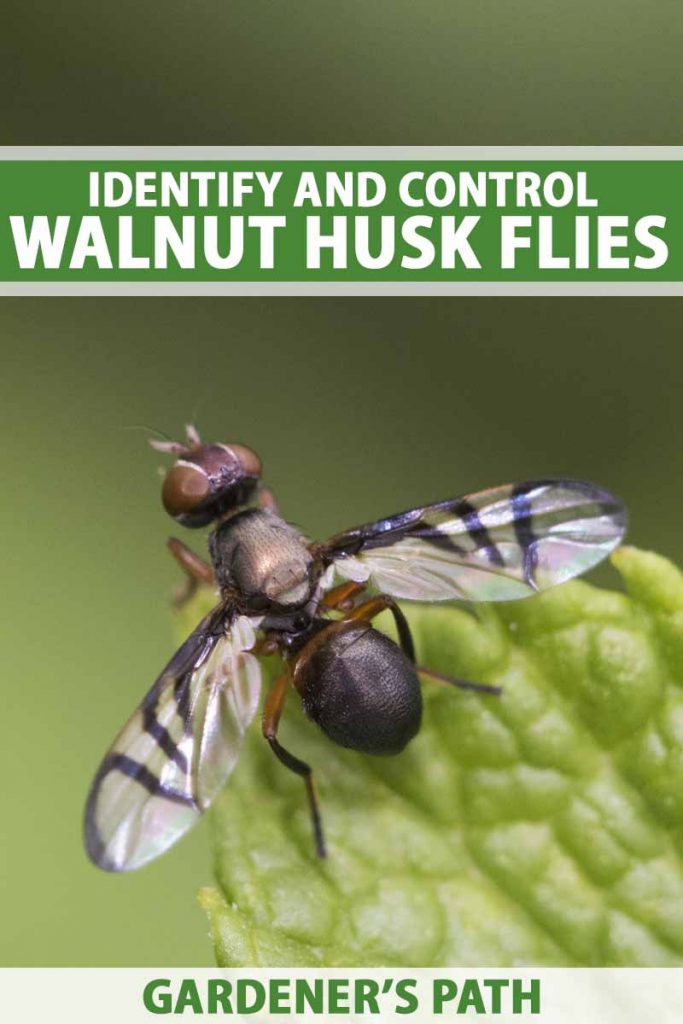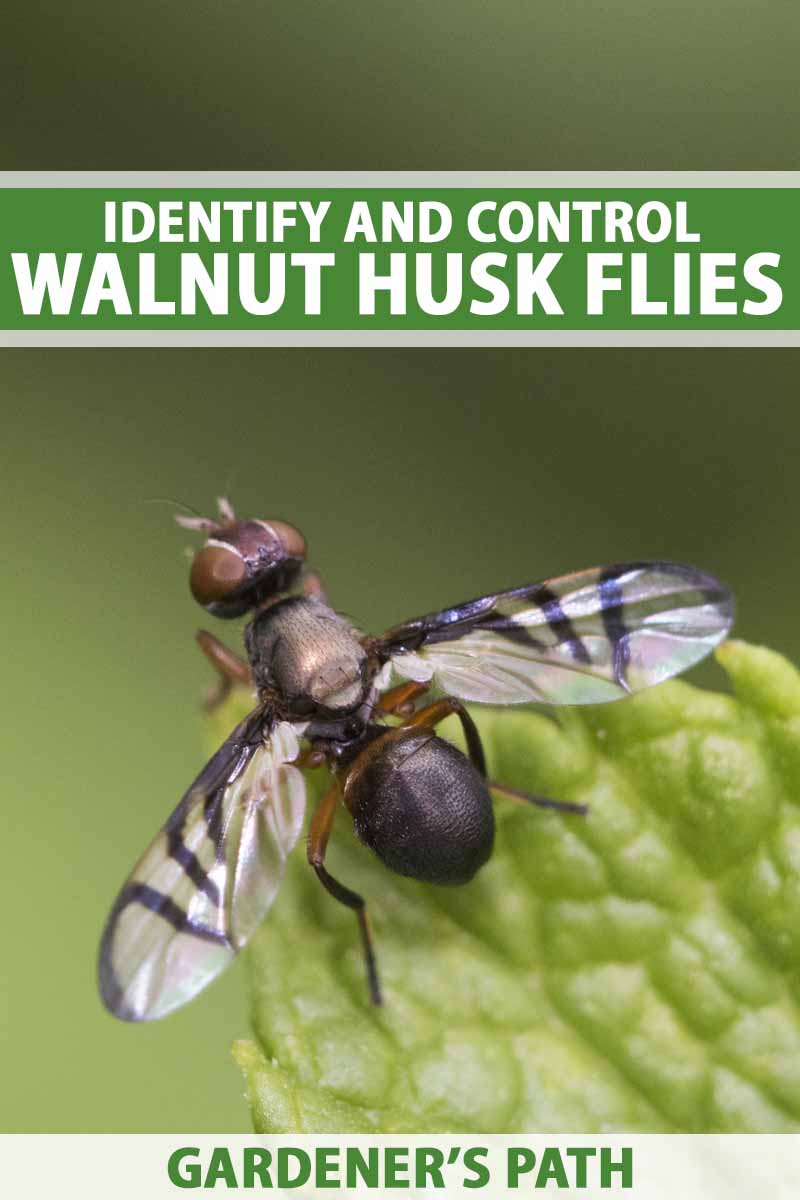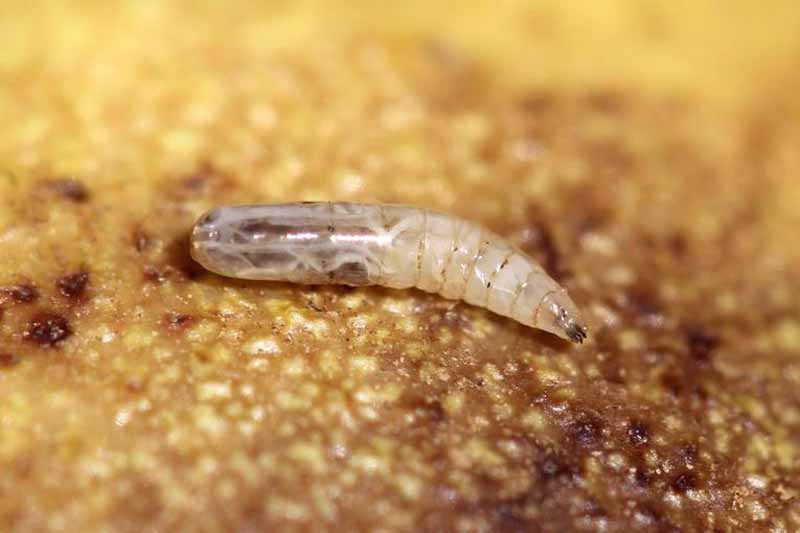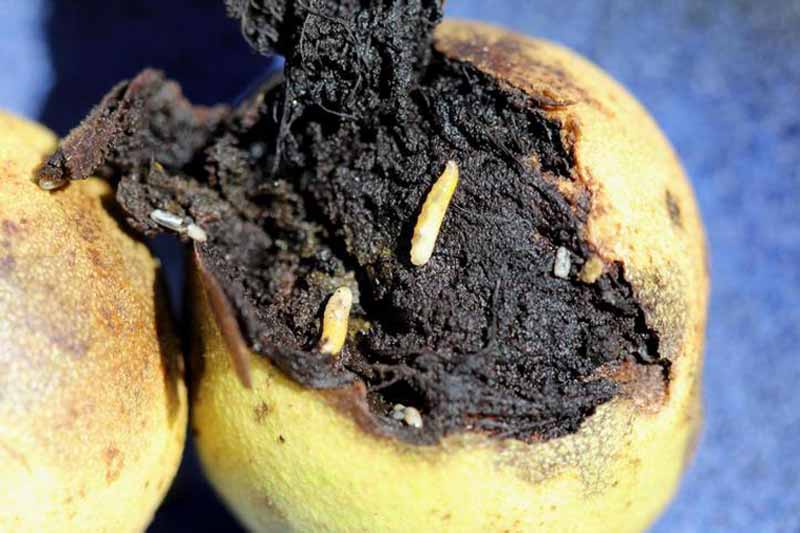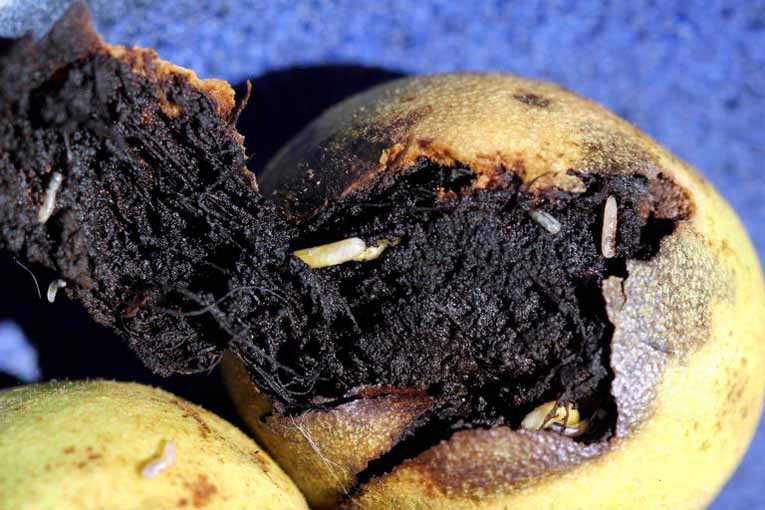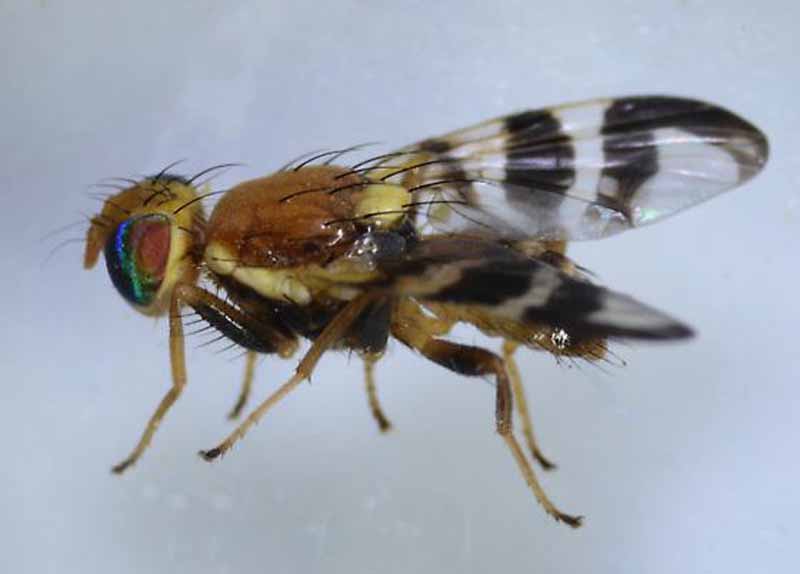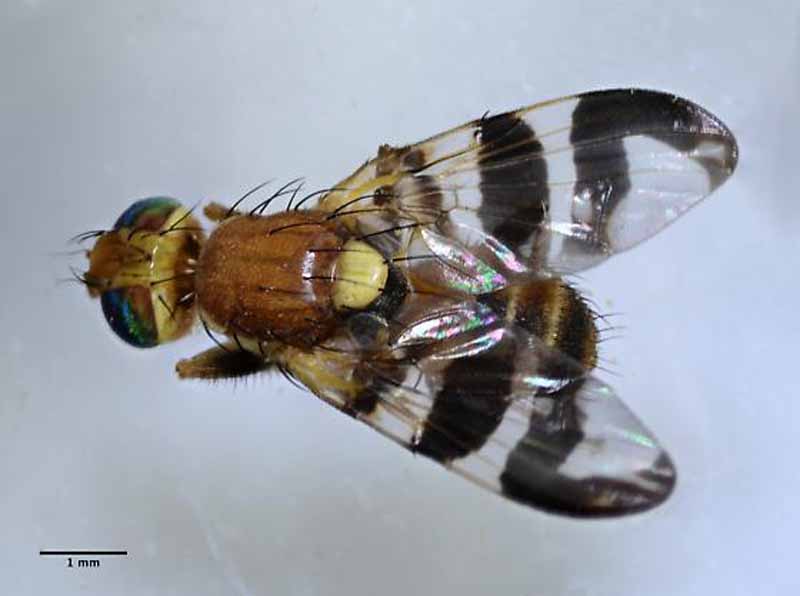However, there is a dark side to growing walnuts, and it comes in the form of a 1/4 inch long insect – the walnut husk fly (Rhagoletis completa). This is the most common pest encountered in both backyard and commercial groves of walnut trees on the West Coast – and a serious problem for growers. Technically, it’s the maggots that are the problem. They feed on the husk that surrounds the nut. We link to vendors to help you find relevant products. If you buy from one of our links, we may earn a commission. Even worse, the kernel may grow mold. You may think of mold as just unpleasant, but this kind of fungus produces a dangerous carcinogen called aflatoxin. And the walnut husk fly is becoming an even more serious problem by showing up much earlier in the season than normal – before the growers are ready for it. We at Gardener’s Path will walk you through the steps to monitor and protect your walnut tree – and when you will need to hire a professional pest control expert.
Identification, Life Cycle and Distribution
The walnut husk fly (WHF) looks so striking that it is easy to identify. It is the size of a housefly but brown with a yellow semicircle on its back. And then there are its unique translucent wings – with large brownish-black bands on them. Adults emerge from the soil from May to early fall and mate within 1-2 weeks. The females then lay eggs just below the walnut husk’s surface. The larvae hatch into white maggots in 5-7 days, and trouble really begins! These 1/2-inch maggots feed on the flesh of the husk. The larvae become yellow with black mouthparts as they mature. As they eat, the process releases the pigment in the walnuts. This compound goes on to stain the shell and change the flavor of the kernel. Worst-case scenario – the husks stick to the shells. This can lead to shriveled and moldy kernels. Eventually these infested walnuts fall to the ground, and the maggots burrow into the soil and pupate for 1-2 years. Unfortunately, the soil keeps these pupae safe from the elements – and also most predators. WHF are native to the southern and central US but spread to the west in the 1920s. Currently, they are a serious problem in California and Washington State where the bulk of US English walnut prodcution occurs. Originally a quarantine pest in Europe, the flies became naturalized in southern Europe in the early 1990s.
Susceptible Walnut Species and Cultivars
Preferred hosts for the WHF include black walnuts and all cultivars of English walnut. Particularly susceptible English walnut cultivars include Franquette, Hartley, Serr, and Tulare. It can be important to know what cultivar you are growing because some cultivars incur damage earlier in the season than others. For example, the flies attack the Hartley, Payne, and Serr cultivars earlier than Chandler.
The Walnut Husk Fly is Spreading!
University of California, Berkeley Emeritus Professor and walnut husk fly expert Bob Van Steenwyk told GrowingProduce.com that the pest is becoming a problem in new areas. In the Sacramento Valley in California, June 1 used to be when you would put your first trap out. Now the pests are arriving earlier in the season – possibly due to the warming of the climate. So you may want to start trapping as early as May 1 in the Golden state.
Effects on Walnuts
The symptoms of this infestation vary depending on when the larvae attack the husk. If the infestations are early in the season, the nuts will still be developing. So the kernels themselves get damaged, and there is the potential for you to lose your whole crop. Early infestations are much more likely to produce the toxic mold growth along with shriveled and darkened kernels. Later infestations stain the shell. The walnut stain won’t bleach out well, so you won’t be able to sell your walnuts in-shell. However, at least the kernel will retain its quality, so if you are growing walnuts to eat, you should be good to go. The problem may be that it may be difficult to remove the hull. However, you can get around that by putting the nuts in a damp burlap bag for several days. It should be easier to remove the hull after that.
How to Monitor Adult Walnut Husk Flies
Unfortunately, since the eggs and larvae are hidden within the husk, they are protected from insecticides. You have to focus your monitoring efforts on the adults, since they are the key stage to control. There is only a short time window to detect the adults before they start laying eggs. Once the eggs have been laid within the husk, the larvae will develop where you cannot reach them. The size of mature walnut trees can make it difficult for homeowners to monitor and control walnut husk flies. It is not unheard of for residential walnut trees to be 120 feet tall! Treating a tree that size will pose problems with pesticide drift. So if you have a large tree, you should consult with a licensed professional. However, if you have a tree that is 10-feet tall or smaller, you can carry out all these steps yourself. You may be familiar with yellow sticky traps. That is what you can use to look for adult flies. According to the University of Californis Integrated Pest Management Program, you will want to get unbaited yellow sticky traps designed for apple maggots (Pherocon AM NB) that have been super-charged with ammonium carbonate to attract the adult flies. Do not use apple maggot traps that already contain bait because they will not attract the WHF. IPM is an ecosystem-focused style of management that allows you to manage your pests more sustainably, helping you to use less harmful pesticides whilst having the added bonus of helping you to get to know our gardens more intimately. Click here to learn more!
Ideally, you should put the trap in the upper half of the canopy on the north side of the trees and at least six feet off the ground. Monitor your traps at least twice a week and preferably more frequently. You want to detect the adults ASAP, so you can kill them before they start laying the eggs that produce the menacing larvae. Remove the flies and put them on a dark background. Look for females – they are the ones with the yellow front legs. (You can see this with a 10X hand lens.) Then check if the female is carrying eggs by gently squeezing her abdomen. The eggs look like small grains of rice. Even if you didn’t detect any flies in the previous year, you should keep monitoring because they can live in the soil for two years. Or they may come from your neighbor’s tree! Share and share alike.
Control
You will have to apply some sort of insecticide to control these pests and protect your walnuts. A bad infestation could cause you to lose your entire crop of in-shell nuts. They will be worthless if they are not shelled. If you grow a shelled cultivar, you could lose half the value of your crop. It is critical that you apply an insecticide ASAP after detecting eggs. Unfortunately, you will need to keep spraying until 1-2 weeks before the hulls split.
Organic Insecticide/Bait
You can buy the organically certified product GF-120 that contains the natural insecticide spinosad along with bait that attracts the flies. GF-120 is as effective as traditional insecticides, but it doesn’t cause the typical negative effects of aphids or mites flaring up. However, you do have to apply it earlier than conventional insecticides because it has to be consumed before it can kill the flies. You should start spraying as soon as you detect any flies. Growers spray this treatment 20-feet high from the back of an ATV, but you can use conventional means to spray a smaller tree. You can also use the Entrust formulation, but you must mix with it with bait that is organic.
Conventional Insecticide/Bait
If you have a large population of WHF, you may want to start spraying with conventional insecticides mixed with bait. One problem with GF-120 is that if you have an enormous quantity of flies, they will eat all the bait. In the GrowingProduce.com article, Dr. Van Steenwyk recommended that growers who are faced with a large population start with a conventional insecticide to reduce the populations and then switch to GF-120 as the WHF populations get lower. With conventional insecticides, you can wait to spray until you see an increase in the number of flies in your traps. These types of sprays will typically provide control for about 3 weeks after application. Baits that you can use include molasses, NU-Lure Bait, and Brandt Insect Bait. Insecticides that are the most effective at killing adult WHF and have minimal impact on bees, natural enemies, and the environment include:
Acetamiprid – effective for 14 days (do not spray around bees) Bifenthrin – effective for 21-28 days Beta-cylfuthrin – effective for 14 days Lambda-cyhalothrin – effective for 14 days
Inspect Your Walnuts for Stings
When the female injects the eggs into the walnut, dark juice will flow from the puncture site. That results in a distinctive teardrop-sized stain on the nut known as a “sting.” You should look for these stings after you have started detecting flies in the traps. Check at least 10 nuts on the north side of your tree. If you see fresh stings, you know that your infestation is still in progress and that you should continue spraying. It is also valuable to check some nuts right before harvest. This is a good way to assess the damage to your walnuts and to determine which trees had more severe infestations. Then you will know that you need to place traps on them next year.
Sanitation in the Fall
For damage control after the fact, you should put a tarp under your tree to catch the walnuts that fall and contain maggots, so they won’t spread into the soil. If you do find infested walnuts, be sure and throw them out in the trash. Do not compost them! It is important to rake after you have harvested your walnuts. Throw out any nuts that haven’t been harvested in case they contain mature maggots.
Selectively Harvest Your Walnuts
When you harvest your walnuts, avoid the ones that are darker in color because they might be infested. You should collect the green-husked walnuts that look more fresh. And de-husk your walnuts as quickly as you can. Monitor all your fallen walnuts. Check the husk for a soft brown spot. If you find one, crack open the walnut and look for eggs and larvae.
Monitoring the Flies is Critical For a Healthy Crop
The walnut husk fly is a highly destructive walnut pest that is difficult to control. The insect spends much of its time in the ground as pupae, and it is untouchable when it is in its larval stage inside the husk. Walnut-Husk-Fly-Control-Cover You only have a few weeks to detect the flies and spray them with insecticides, and monitoring with sticky traps is the key factor that will tell you whether you should spray or not. You will need to remain vigilant because the flies can stay in the ground for two years or more. However, if you take the right precautions, you can have a good crop of walnuts. © Ask the Experts, LLC. ALL RIGHTS RESERVED. See our TOS for more details.
